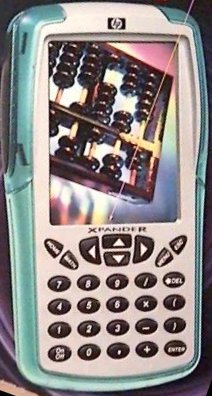The following article is in the August 2000 issue of hp^c, pages 1-3
Stylus, style and math savvy: Xpanded learning power is at hand.
Your Wildest Dreams
by G. T. Springer

|
Go grab any software package on the market today and you’re likely to read claims
of "interactive" or "dynamic," or a user interface that is
"intuitive" or "easy-to-use." Few actually deliver on that promise, of
course -- with no concrete definition of such attributes, anyone can claim them -- which
makes those products that do deliver so startlingly superior that it’s a shame you
can’t tell just by reading the box. So, how will I recognize such qualities in the
next generation of software, specifically in my field, which is hand-held technology
designed exclusively for education? Surely it will claim to be all of the above. It must
be interactive to engage students, and it must be dynamic to help them make connections.
The interface must be easy-to-use and intuitive so that classroom time is spent on using
the device to learn mathematics, not on learning how to use the device.
Now, how could such promises be delivered? Let me fantasize.... |
An interactive grapher would let us enter graphs in a variety of ways. We’d just
make a sketch right on the screen, and convert it into a mathematically correct graph on
the fly. If that grapher were truly dynamic, moreover, we could control the graph window
-- move around or zoom in or out directly -- without a separate environment for the window
settings. And we’d have equally direct ways of translating and dilating existing
graphs, seeing the effects on the equations at the same time that the transformations
occur.
Likewise, a dynamic and interactive geometry environment would proactively encourage
speculation and exploration. A triangle could be constrained to be a right triangle at one
time and obtuse at another, without reconstructing. If a student were to draw what appears
to be a right triangle, the device might even ask the student if he/she would like the
triangle to have that property.
Wouldn’t that be great? Such an intuitive interface in these fundamental topic
areas would really foster mathematical thinking -- with a maximum of transparency between
thought and deed. It would accept the way we work with paper and pencil and try to bring
those ways to life on an active screen. It might even offer electronic lessons, formatted
to focus a student’s attention, engage the student’s imagination, and encourage
conceptual rather than computational development.
And a truly revolutionary device might even go one step farther and give teachers the
took they need to create their own electronic lessons -- faster than they could document
them in their lesson plans. That would be a dream come true.
(And by the way: shouldn’t a product this interactive and dynamic be useful in
science, too? And languages, social studies, art, music, football..? You heard it here
first.)
What is Xpander?
Xpander is a friendly, engaging, personal handheld learning partner for high school
teachers and students. It has fewer keys, a larger screen and easy stylus input for
seamless learning -- anywhere, anytime. Xpander comes ready with exploratory math learning
software and e-lessons to help students learn by doing, not by rote. And its flexible
expansion card slot and PC connectivity open the door to multi-subject learning,
communication, memory expansion and many other exciting future possibilities. All this --
in a package that fits into the palm of your hand (6.4" x 3.5" x 0.9") and
runs on two rechargeable AA batteries.
What does this mean for math learning?
It means that students can learn more intuitively, flexibly and individually. Xpander
has interactive and dynamic environments for geometry, algebra, tables and matrices. As
students use the stylus (pen) directly on the large grayscale screen, they see equations,
graphs and table values all change together, in real time. And with built-in demonstration
interactive e-lessons, teachers can harness this dynamic power in self-contained lesson
units to reach more students with less time, effort and stress.
How is Xpander different than [sic] a calculator?
First, it’s more user-friendly and engaging. It has fewer buttons, a larger
screen, on-line help and pen-based input. It’s also more exploratory, with a
discovery-based interface, built-in math learning software and e-lessons. And even with
all that, it’s more flexible too. Its compact flash card slot presents opportunities
for learning beyond math and science: with future memory expansion, fun and communication
possibilities, the sky’s the limit.
